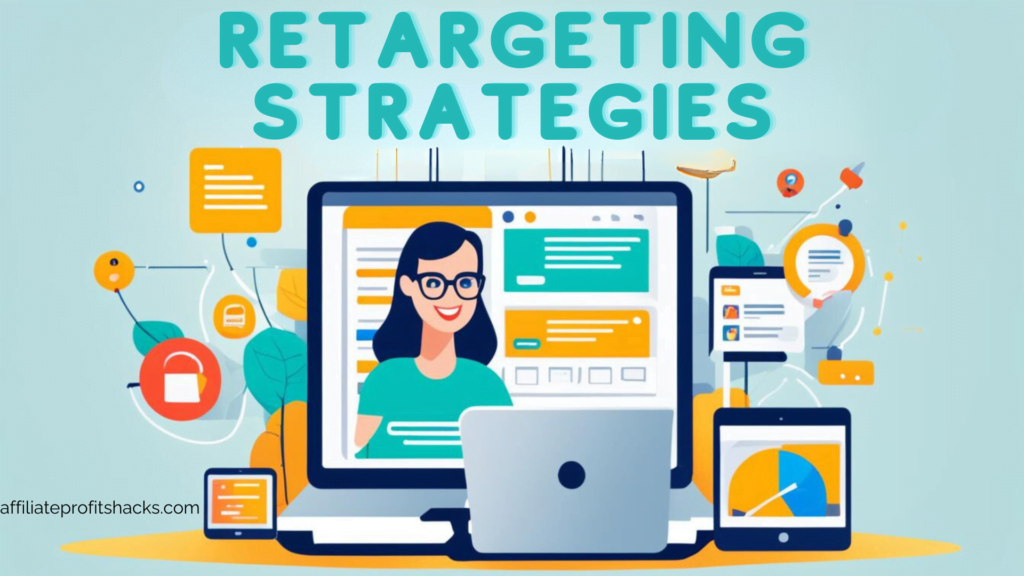Retargeting Strategies to Re-Engage Your Audience
Welcome to my article about retargeting strategies so that you can re-engage your audience!
Are your digital marketing efforts falling short in engaging your audience and driving conversions?
It’s time to consider implementing retargeting strategies to re-engage your audience and boost your conversion rates. By reconnecting with website visitors and targeting a highly qualified audience who has already shown interest in your brand, you can effectively stay top of mind and increase the chances of conversions.
Best Recommended and Proven Way to Make Money Online – Click HERE for Instant ACCESS >>

This article will explore the power of retargeting, its different types, best practices, and how it can enhance your overall digital marketing strategy. Get ready to optimize your customer retention techniques and unlock the potential of retargeting to maximize your online advertising efforts.
Key Takeaways:
- Retargeting allows you to re-engage with your audience and boost conversions.
- Targeting a highly qualified audience who has shown interest in your brand is cost-effective and increases conversion rates.
- Various retargeting strategies include website retargeting, social media retargeting, web push retargeting, and email remarketing.
- Following best practices such as strategic targeting, compelling ad creative, and continuous testing will optimize your retargeting campaigns.
- You can effectively re-engage your audience and drive long-term digital marketing success by leveraging retargeting strategies.
Understanding Retargeting in Search Engine Marketing (SEM)
Retargeting is a crucial search engine marketing (SEM) strategy that can significantly enhance your advertising efforts. In SEM, you can show targeted ads to users who have previously interacted with your brand, increasing the chances of conversion. SEM involves leveraging search engines like Google to promote your ads through targeted keyword bidding.
When combined with retargeting, SEM allows you to re-engage users who have already shown interest in your brand. Using SEM platforms like Google Ads, you can bid on keywords related to your business and display ads to users who have interacted with your website or clicked on your previous ads. This highly qualified audience is more likely to convert, boosting your overall campaign performance.
Retargeting in SEM helps you stay in mind with potential customers and encourages them to act. By displaying relevant ads to users who have already engaged with your brand, you can reinforce your message and increase the likelihood of conversion. This strategy maximizes your advertising budget by focusing on users who are more likely to convert rather than targeting a broad audience.
To illustrate the effectiveness of retargeting in SEM, consider a user who visits your website after clicking on one of your SEM ads. With retargeting, you can display ads to this user as they continue browsing the web, reminding them of your brand and encouraging them to return to your website.
Retargeting in SEM is a powerful tool that allows you to connect with users who have already shown interest in your brand. By combining SEM with retargeting, you can optimize your digital advertising campaigns, increase conversions, and maximize return on investment.
Retargeting in SEM Benefits:
- Target a highly qualified audience that has already engaged with your brand.
- Increase conversion rates by re-engaging with potential customers.
- Optimize your SEM efforts by focusing on users who are more likely to convert.
- Stay top of mind with your audience, reinforcing your brand message.
With retargeting in SEM, you can leverage the power of search engine marketing to re-engage your audience and drive conversions. Combining SEM with retargeting allows you to target users who have shown interest in your brand and increase the effectiveness of your advertising campaigns.
Different Types of Retargeting
Retargeting is a powerful strategy that allows you to re-engage your audience and drive conversions. There are various types of retargeting strategies that you can use to reconnect with your website visitors and increase brand exposure. Let’s explore some of the most effective types of retargeting:
Website Retargeting
Website retargeting involves showing ads to users who have previously visited your website. By targeting these users, you can remind them of your brand, products, or services, and encourage them to take action. Website retargeting is an effective way to stay top of mind with your audience and increase conversion rates.
Social Media Retargeting
Social media retargeting allows you to target users who interact with your brand on social media platforms. Using platforms such as Facebook, Instagram, or Twitter, you can show ads to users based on their engagement with your brand’s social media profiles, posts, or ads. Social media retargeting enables you to re-engage users when they are active on these platforms, increasing the chances of conversions.
Web Push Retargeting
Web push retargeting utilizes push notifications to re-engage users who have engaged with your website. By sending targeted push notifications to these users, you can remind them of your brand and encourage them to revisit your website or take specific actions. Web push retargeting is a highly effective strategy to reach users even when they are not browsing your website.
Web push retargeting enables you to deliver highly targeted messages to users who have already expressed interest in your brand, increasing the likelihood of conversions.
Email Remarketing
Email remarketing involves sending targeted emails to users who have previously interacted with your brand. These users may have subscribed to your newsletter or purchased or abandoned their shopping cart. Email remarketing can effectively re-engage users and drive conversions by sending personalized emails with relevant offers or reminders.
These different retargeting strategies offer various ways to reengage your audience and increase conversions. Combining multiple retargeting methods, you can create comprehensive campaigns that remind users of your brand and encourage them to act.
Best Practices for Retargeting
To make the most of your retargeting campaigns, it’s essential to follow best practices. Here are some key strategies to consider:
- Strategic Targeting: Segment your audience based on their behavior and interests. This ensures that you’re showing relevant ads to the right users.
- Compelling Ad Creative: Use eye-catching and engaging ad creative that grabs users’ attention. Include a clear call to action to encourage them to take the desired action.
- Frequency Caps: Set frequency caps to prevent ad fatigue and create a positive user experience. Too many repetitive ads can annoy users and diminish the effectiveness of your campaign.
- Testing and Optimization: To improve results, test and optimize your retargeting campaigns. Experiment with different ad creative, targeting options, and messaging to find what resonates best with your audience.
By implementing these best practices, you can maximize the effectiveness of your retargeting campaigns and increase the chances of re-engaging your audience.
Example:
Segmenting our audience based on their behavior and interests has been a game-changer for our retargeting campaigns. Instead of targeting everyone with the same ad, we can deliver personalized messages that resonate with each group. This has significantly increased our conversion rates and overall ROI.
Remember, retargeting is a dynamic and evolving strategy, so it’s important to stay up-to-date with industry trends and adapt your approach.
How Google Retargeting Works
Google retargeting is a powerful strategy that allows you to reconnect with users who have previously interacted with your website or other Google properties. By showing ads specifically to this audience, you can increase the likelihood of conversions and drive better results for your retargeting campaign.
To begin using Google retargeting, you must install a remarketing tag on your website. This tag, a small piece of code, places a cookie in users’ browsers when they visit your site, enabling Google to identify them as someone who has shown interest in your brand.
Once the remarketing tag is in place, you can create a remarketing audience in Google Ads. This audience consists of the users who have triggered the remarketing tag by visiting your website. By defining this audience, you can ensure that your retargeting campaign targets the right people.
After creating the remarketing audience, you can set up your retargeting campaign in Google Ads. This involves creating ad groups and ads specifically tailored to this audience. You can bid on ad placement in the Google Display Network, where your ads will be shown on relevant websites and apps.
Tracking and optimizing your retargeting campaign is crucial for its success. Google Ads provides reporting tools that allow you to monitor the performance of your ads, including impressions, clicks, and conversions. By analyzing this data, you can make informed decisions about optimizing your campaign for better results.
Retargeting Strategies That Work
Effective retargeting strategies can make a significant difference when re-engaging your audience. By implementing the right tactics, you can optimize your campaigns and increase your chances of attracting and converting customers. Here are some proven retargeting strategies that you should consider:
- Retargeting specific URL visits: By targeting users who have visited particular pages on your website, you can deliver ads relevant to their interests. This personalized approach increases the chances of re-engagement and conversions.
- Segmenting your visitors: Understanding where your visitors are in the buyer’s journey allows you to tailor your retargeting campaigns accordingly. By delivering content and offers that align with their needs, you can capture their attention and encourage them to take the desired action.
- Excluding converted users: Once a user has converted, there’s no need to continue showing them ads. By excluding converted users from your retargeting campaigns, you can allocate your resources more effectively and focus on retaining them as loyal customers.
- Demographic targeting: Delivering ads tailored to specific demographic groups can significantly improve the effectiveness of your retargeting campaigns. By understanding your audience’s demographics and adjusting your messaging accordingly, you can enhance the relevancy and impact of your ads.
- A/B testing: Testing and optimizing your retargeting campaigns is crucial for continued success. By experimenting with different ad creatives, targeting options, and messaging, you can identify the best strategies for your audience and maximize your conversion rates.
Best Recommended and Proven Way to Make Money Online – Click HERE for Instant ACCESS >>
These retargeting strategies can help you reconnect with your audience, increase engagement, and drive conversions. It’s essential to continually evaluate and optimize your campaigns to ensure you deliver the most effective messages and offers to your target audience.
By implementing the right retargeting strategies, you can effectively re-engage users and increase your conversion rates.
To further illustrate the effectiveness of these strategies, let’s take a closer look at a case study:
Case Study: Increasing Conversions with Retargeting Specific URL Visits
In a recent campaign by XYZ Electronics, retargeting specific URL visits proved to be a game-changer. By targeting users who had visited the product pages of a recent smartphone launch, XYZ Electronics was able to deliver ads highlighting the product’s unique features and benefits. This approach resulted in a 25% increase in conversions compared to previous campaigns.
By segmenting visitors and analyzing their interests, XYZ Electronics delivered personalized ads that resonated with their target audience. Through continuous A/B testing, they refined their ad creatives and messaging to optimize their conversions further.
Implementing effective retargeting strategies, such as retargeting specific URL visits, segmenting your visitors, excluding converted users, demographic targeting, and A/B testing, can significantly improve the success of your campaigns. By tailoring your strategies to your target audience and optimizing your approach, you can increase engagement, drive conversions, and achieve your marketing goals.
The Power of Behavioral Retargeting
Behavioral retargeting is a powerful strategy that leverages user behavior to create personalized campaigns and increase conversions. You can gain valuable insights into their preferences and interests by analyzing user data, such as past purchases or abandoned carts.
With behavioral retargeting, you can deliver relevant and tailored messaging to users based on their specific actions within your app or website. This personalized approach significantly increases the chances of re-engagement and conversions as it addresses their needs and interests.
Understanding how users interact with your brand allows you to create highly effective campaigns that resonate with them. Behavioral retargeting will enable you to target users who have shown a genuine interest in your products or services, making it a highly efficient and cost-effective strategy.
To implement behavioral retargeting effectively, it is essential to analyze user data and segment your audience based on their behaviors. By identifying patterns and trends, you can create personalized campaigns that deliver the right message at the right time.
Behavioral retargeting allows you to deliver relevant and tailored messaging to users, increasing re-engagement and conversions.
For example, if a user has previously added items to their cart but didn’t complete the purchase, you can retarget them with personalized ads that offer discounts or incentives to encourage them to return and complete the transaction.
Another example is retargeting users who have shown interest in a specific category of products. By analyzing their browsing behavior, you can show them ads featuring related products or recommendations that align with their preferences.
Behavioral retargeting goes beyond basic demographic targeting and allows you to create highly personalized campaigns considering individual user behavior. By delivering relevant and tailored messaging, you can significantly improve the effectiveness of your retargeting efforts.
To achieve optimal results with behavioral retargeting, it is essential to analyze and optimize your campaigns continuously based on user data. Testing different ad creatives, messaging, and targeting strategies can help you find the most effective approach for your audience.
Image:
Leveraging Contextual Retargeting
Contextual retargeting is a powerful strategy that allows you to target users based on the context of the web pages or content they are viewing. By delivering ads relevant to the specific content or topic of interest, even if the user’s previous behavior may not be directly related, you can capture their attention and increase the chances of re-engagement and conversions.
With contextual retargeting, you can connect with users when their interest is piqued at the right moment. You can grab their attention by displaying ads aligning with their current web page or content and driving them back to your website or app.
For example, if a user reads an article about outdoor adventures, you can use contextual retargeting to display hiking gear or camping equipment ads. This relevancy increases the likelihood that the user will click on the ad, further engaging with your brand and potentially making a purchase.
Contextual retargeting allows you to target users precisely based on their immediate interests and needs. By presenting relevant ads, you create a personalized experience that resonates with users, increasing the chances of conversion.
Contextual retargeting enables you to showcase your products or services in a way that complements the content users are already engaged with, capturing their attention and driving them back to your brand.
By leveraging contextual retargeting, you can enhance your retargeting campaigns and maximize your efforts to re-engage users. This strategy enables you to deliver relevant ads that align with users’ current interests, increasing the effectiveness of your retargeting efforts and ultimately driving conversions.
Retargeting Users Based on Funnel Stage
Retargeting users based on their position in the buyer’s journey can be a highly effective strategy. By understanding the different stages of the funnel, you can tailor your retargeting campaigns to meet your audience’s specific needs and mindset.
In the awareness stage, users may have just become aware of your brand or product and may not be ready to purchase. To capture their interest, you can retarget them with educational content that showcases the value and benefits of your app or brand. By providing valuable information, you can build trust and establish yourself as an expert in your industry.
Once users move into the consideration stage, they are actively researching and evaluating their options. At this stage, you can retarget them with social proof, such as customer testimonials or reviews, to showcase the positive experiences others have had with your app or product. Additionally, you can provide personalized product recommendations based on their previous interactions, helping them make an informed decision.
In the decision stage of the funnel, users are ready to convert and make a purchase. At this critical stage, you can retarget them with incentives like discounts or exclusive offers to encourage them to take action. By providing a sense of urgency or highlighting the unique benefits of your product, you can nudge them towards completing their purchase.
By aligning your retargeting campaigns with the user’s mindset at each funnel stage, you can increase the chances of re-engagement and conversions. Understanding where your audience is in their buyer’s journey allows you to deliver the right message at the right time, providing them with the information and motivation they need to move forward.
Best Recommended and Proven Way to Make Money Online – Click HERE for Instant ACCESS >>
Retargeting users based on their funnel stage is an effective way to maximize the impact of your retargeting efforts and drive results. By being strategic in your approach and delivering relevant messaging, you can increase engagement, conversions, and, ultimately, the success of your digital marketing campaigns.
The Role of Ad Retargeting in Re-Engagement
Ad retargeting is a powerful strategy for re-engaging users and reminding them of your brand or product. You can effectively reach your target audience and drive conversions by strategically placing ads across different platforms. Let’s explore the various types of ad retargeting that can help you re-engage users and maximize your marketing efforts.
Social Media Retargeting
Social media retargeting, including Facebook retargeting, allows you to target users who have previously interacted with your app or website on popular social media platforms. By showing ads to these users as they scroll through their social media feeds, you can re-engage them and remind them of your brand’s value.
Display Retargeting with Google Ads
Display retargeting with Google Ads enables you to target users across the vast network of websites and apps participating in the Google Display Network. As users browse other websites or apps, your ads can appear, reinforcing your brand’s presence and encouraging them to take action.
Cross-Device Retargeting
Cross-device retargeting ensures consistent brand exposure by targeting users across multiple devices they use. This strategy allows you to reach users on their smartphones, tablets, and computers, keeping your brand in mind as they switch between devices.
CTV Retargeting
CTV (Connected TV) retargeting taps into the growing popularity of streaming services to reach a large and engaged audience. By showing ads on popular streaming platforms, you can re-engage users in a contextually relevant environment and drive conversions.

By leveraging the ad retargeting strategies mentioned above, you can effectively re-engage users, increase brand awareness, and drive conversions. These strategies provide multiple touchpoints for reminding users of your brand’s value and encouraging them to take action. With careful planning and optimization, ad retargeting can play a crucial role in the success of your re-engagement efforts.
Best Practices for Retargeting Success
To succeed with retargeting, it’s essential to follow best practices. Implementing these strategies can optimize your retargeting campaigns and maximize your results.
- Optimize for Opt-Ins: One of the first steps in effective retargeting is to optimize your app for opt-ins. Encourage users to provide their consent and gather the data needed to create personalized retargeting campaigns.
- Define Clear Goals and KPIs: Before launching your retargeting campaigns, clearly define your goals and establish key performance indicators (KPIs) to measure their success. This will help you track and evaluate your results accurately.
- Optimize Frequency and Duration: Find the right balance for the frequency and duration of your retargeting ads. You want to maintain visibility without overwhelming users. Continually monitor and adjust these factors to optimize campaign performance.
- Personalize Ads and Messages: Personalization is critical to grabbing users’ attention and increasing engagement. Tailor your ads and messages to each user’s needs and preferences, making them relevant and impactful.
- Test and Optimize: Testing and optimization are vital for improving the effectiveness of your retargeting campaigns. Experiment with different ad creative, targeting options, and messaging to identify what resonates best with your audience. Continuously analyze the results and make data-driven adjustments to enhance performance.
“Implementing best practices for retargeting can significantly improve your campaign’s effectiveness and drive higher conversions. By optimizing for opt-ins, defining clear goals and KPIs, optimizing frequency and duration, personalizing ads and messages, and continuously testing and optimizing, you can create a powerful retargeting strategy that delivers results.”
Conclusion
Retargeting strategies are a crucial component of effective digital marketing. They allow you to re-engage your audience and boost conversions. By targeting a highly qualified audience who has already shown interest in your brand, you can stay top of mind and increase your chances of driving conversions.
Implementing retargeting best practices is critical to maximizing the impact of your campaigns. Strategic targeting, where you segment your audience based on their behavior and interests, ensures that you deliver relevant ads to the right users. Compelling ad creative and clear call-to-actions grab users’ attention and encourage them to take action. Continuously test and optimize your retargeting campaigns to improve their effectiveness over time.
With the right retargeting strategies, you can effectively re-engage your audience and drive long-term success in your digital marketing efforts. Personalizing your messaging and keeping your brand in mind can boost conversions and generate a higher return on investment. Retargeting is an essential element of your marketing strategy, and unlock its full potential to achieve your business goals.
Best Recommended and Proven Way to Make Money Online – Click HERE for Instant ACCESS >>
Thank you for reading my article “Retargeting Strategies to Re-Engage Your Audience.” I hope you found it informative and helpful!
For more insights into content marketing, read this article: Content Marketing Strategy: The Future of Digital Engagement.







